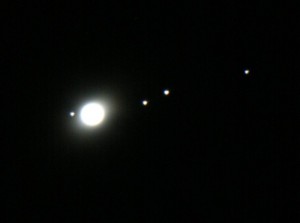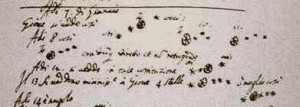The Galilean Moons
In January 1610 Galileo Galilei first observed the four moons of Jupiter now known, appropriately, as “The Galilean Moons”. The largest of the many moons of Jupiter, Galileo initially named his discovery the Cosmica Sidera (“Cosimo’s stars”) but they are now known by the names given by Simon Marius in his 1614 Mundus Jovialis: Io, Europa, Ganymede and Callisto – the lovers of Zeus.
Galileo first noticed Saturn’s peculiar shape later in 1610, well after the publication of his landmark book Sidereus Nuncius. The story of how he initially revealed the new discovery to his fellow astronomers by means of an anagram is told in a 1974 article by Albert van Helden of Rice University.
Galileo’s discovery of celestial bodies orbiting something other than the Earth dealt a serious blow to the Ptolemaic, or the geocentric, cosmology in which the universe orbits around the Earth. The possibility of viewing Saturn’s moons was made possible by improvements Galileo made to his telescope in 1609. Images of the moons as seen through Galileo’s telescope can be viewed here. Matk Thompson’s website Galileo 1610 has a wealth of information about Galileo as does Rice University’s Galileo Project website.

